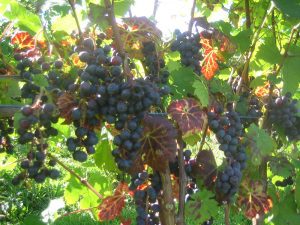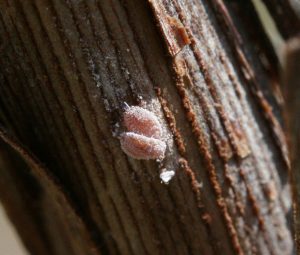
Leafroll is the most widespread and devastating viral disease of grapevine worldwide. It reduces yield, delays fruit ripening, increases titratable acidity, lowers sugar content in fruit juices, modifies aromatic profiles of wines and shortens the productive lifespan of vineyards. The economic cost of leafroll is estimated to range from $12,000 to $92,000 per acre of ‘Cabernet Sauvignon’ in California (Ricketts et al. 2015).
Grapevine leafroll-associated virus 3 (GLRaV 3) is the most dominant virus in leafroll-diseased vineyards. This virus is phloem-limited and transmitted by vegetative propagation and grafting as well as by several species of mealybugs. Mealybugs are sap-sucking insects and pests of grapes. At high densities, mealybugs can cause complete crop losses, rejection of fruit loads at wineries and death of spurs, although small infestations may not inflict significant direct damage. Several mealybug species feed on grapevines in California vineyards, including vine mealybug (Planococcus ficus), grape mealybug (Pseudococcus maritimus), obscure mealybug (Pseudococcus viburni) and longtailed mealybug (Pseudococcus longispinus) (Daane et al. 2012). Vine mealybug is an invasive species and the most damaging of the mealybugs that occur in California vineyards. Unassisted, mealybugs have limited mobility, but immature instars (crawlers) can be dispersed over long distances by wind and other means.
GLRaV-3 is acquired within one hour or less when instar mealybugs feed on infected grapevines. The virus is transmitted in a similar short time to healthy grapevines (Tsai et al. 2008). Following inoculation of healthy grapevines, it takes at least three months for GLRaV-3 to be detected in inoculated grapevines using laboratory-based diagnostic assays and one year for inoculated vines to exhibit typical leafroll disease symptoms in the vineyard (Blaisdell et al. 2016). In most diseased vineyards, the dynamics of leafroll spread is influenced by virus incidence and mealybug population density (Arnold et al. 2017, Cooper et al. 2018). In addition, the two adjacent vines to an infected vine are more likely to become infected over time than their counterparts located across the row, suggesting a predominant within-row virus spread and a spatial dependence for secondary spread (Bell et al. 2018).
Current Management Options
There is no cure for leafroll in diseased vineyards. However, the disease can be managed by reducing the number of infected vines and by controlling mealybug vector populations. For example, the elimination of diseased vines (a strategy known as roguing) and their replacement with clean vines derived from virus-tested nursery stocks that test negative for economically relevant viruses, including leafroll-associated viruses, reduce the incidence of GLRaV-3 and limit its secondary spread in vineyards (Bell et al. 2018, MacDonald et al. 2021).

Spatial Roguing, a New Response to Leafroll
Modelling leafroll disease spread in relation to economic factors predicted when roguing diseased vines, if disease prevalence is less than 25% (Ricketts et al. 2015) and two immediate within-row neighboring vines on each side, regardless of their disease status (for a total of five vines in the case of one infected vine), a strategy referred to as spatial roguing is more effective at reducing the level of virus inoculum in a diseased vineyard than roguing only diseased vines (Atallah et al. 2015). This strategy was inspired by the fact that 1) mealybug crawlers are more efficient vectors of leafroll viruses than adults; 2) crawlers are more likely to move along rows than between rows; 3) leafroll spread predominantly occurs at a short spatial scale; 4) a healthy-looking vine that is adjacent to a diseased vine may be infected without exhibiting disease symptoms; and 5) disease symptoms are only apparent at least one year after inoculation by viruliferous mealybugs (Blaisdell et al. 2016). Predictive models suggested that spatial roguing targeting symptomatic vines and their four immediate neighbor vines, two on each side, would be of statistically significant greater economic value than spatial roguing targeting symptomatic vines and their two immediate neighbor vines, one on each side. Simulations further predicted that a nonspatial strategy targeting only diseased vines is less effective and more costly than spatial roguing (Atallah et al. 2015).
We applied spatial roguing in a ‘Cabernet franc’ vineyard with overall low leafroll virus prevalence (5%) and a low grape mealybug population density in New York and tested its effectiveness at reducing the incidence of leafroll disease and slowing virus spread (Hesler et al. 2022). Four treatments were applied to select vine panels from 2016 to 2021: (1) spatial roguing only, (2) spatial roguing in combination with insecticide applications targeting grape mealybugs, (3) insecticide applications only (no spatial roguing), and (4) no spatial roguing and no insecticide intervention (the untreated control). Results showed that virus incidence was reduced from 5% in 2016 to less than 1% in 2020 to 2021 in both spatial roguing treatments. Among vines in the insecticide-free, non-rogued control treatment, virus incidence increased from 5 to 16% from 2016 to 2021 (Hesler et al. 2022). Insecticides applied in 2016 to 2021 helped significantly reduce grape mealybug populations to near zero annually, while populations in the untreated control vines were 57- to 257-fold higher during the same period (Hesler et al. 2022). This work validated spatial roguing as a leafroll disease management response in a vineyard with low disease incidence and low grape mealybug abundance.

Spatial roguing adds to the overall cost of vineyard maintenance. Revenue losses directly related to spatial roguing were estimated in our study at $5,565 per acre over six years (Hesler et al. 2022). These estimates agreed with earlier predictions and underscored the economic value of spatial roguing, despite added costs relative to the costs of maintaining a healthy vineyard, particularly when considering a scenario of no intervention, for which $10,000 to $15,750 losses per acre were calculated over a 25-year lifespan of a ‘Cabernet franc’ vineyard in New York (Atallah et al. 2012). The cost/benefit analysis of roguing may need to be evaluated by individual vineyard owners who are willing to adopt this leafroll disease management strategy. Critical to the success of roguing is the health status of the replants. Replants should be sourced from nursery vine stocks (scions and rootstocks) that have been extensively tested for viruses, including leafroll viruses, and shown to be clean (Bolton 2020).
In the future, it would be interesting to test the effectiveness of spatial roguing in California vineyards where mealybug population densities are consistently higher than in New York vineyards. Similarly, it would be interesting to compare the efficacy of spatial and nonspatial roguing approaches as a response to leafroll disease management. Of equal interest would be a study to test whether a sequential roguing strategy based first, for instance, on spatial roguing to drastically reduce sources of virus inoculum, and then on nonspatial roguing to limit secondary spread would be of value. If carried out in different vineyards with distinct disease prevalence, rate of spread and mealybug species and abundance, such research would inform the best approach for leafroll disease management both from a biological and economical perspective.
A six-year experiment in a commercial ‘Cabernet franc’ vineyard with low disease prevalence and low-density grape mealybug populations in New York showed that spatial roguing and the combination of spatial roguing and insecticides significantly reduced the percentage of infected vines. By comparison, virus incidence among vines in the untreated control vine panels where roguing was not implemented and no insecticides were applied increased from 5% to 16% during the same period. This study was the first to demonstrate the effectiveness of spatial roguing at reducing the incidence of leafroll disease and limiting its spread. It will be interesting to see whether our results on spatial roguing are reproducible in other vineyards of New York, and in vineyards of other grape growing regions of the world, including in California, where many more mealybug species, including the vine mealybug, are of concern and reside at higher populations.
References
Arnold K, Golino DA and McRoberts N. 2017. A synoptic analysis of the temporal and spatial aspects of grapevine leafroll disease in a historic Napa vineyard and experimental vine blocks. Plant Dis 107:418-426.
Atallah S, Gómez M, Fuchs M and Martinson T. 2012. Economic impact of grapevine leafroll disease on Vitis vinifera cv. Cabernet franc in Finger Lakes vineyards of New York. Am J Enol Vitic 63:73-79.
Atallah S, Gómez M, Conrad JM and Nyrop JP. 2015. A plant-level, spatial, bioeconomic model pf plant disease diffusion and control: grapevine leafroll disease. Am J Agri Econ 97:199-218.
Bell VA, Hedderley DI, Pietersen G and Lester PJ. 2018. Vineyard-wide control of grapevine leafroll-associated virus 3 requires an integrated response. J Plant Pathol 100:399-408.
Blaisdell GK, Cooper ML, Kuhn EJ, Taylor KA, Daane KM and Almeida RPP. 2016. Disease progression of vector-mediated Grapevine leafroll-associated virus 3 infection of mature plants under commercial vineyard conditions. Eur J Plant Pathol 146-105-116.
Bolton SL. 2020. What every winegrower should know: viruses. Lodi Winegrape Commission. pp. 138.
Cooper ML, Daugherty MP, Jeske DR, Almeida RPP and Daane KM. 2018. Incidence of grapevine leafroll disease: effects of grape mealybug abundance and pathogen supply. J Econ Ent 111:1542-1550.
Daane KM, Almeida RPP, Bell VA, Walker JTS, Botton M, Falladzadeh M, Mani M, Miano JL, Sforza R, Walton WM and Zaviezo T. 2012. Biology and management of mealybugs in vineyards. In Arthropod Management in Vineyards: Pests, Approaches, and Future Directions, N.J. Bostanian, ed. (Springer), pp. 271-307.
Hesler S, Cox R, Loeb G, Bhandari R, Martinson T and Fuchs, M. 2022. Spatial roguing reduces the incidence of leafroll disease and curtails its spread in a ‘Cabernet franc’ vineyard in the Finger Lakes region of New York. Am J Enol Vit 73:227-236.
MacDonald, SL, Schartel TE and Cooper ML. 2021. Exploring grower-sourced data to understand spatiotemporal trends in the occurrence of a vector, Pseudodoccus maritimus (Hemiptera: Pseudococcidae) and improve grapevine leafroll disease management. J
Ricketts KD, Gómez MI, Atallah SS, Fuchs MF, Martinson T, Smith RJ, Verdegaal PS, Cooper ML, Bettiga LJ and Battany MC. 2015. Reducing the economic impact of grapevine leafroll disease in California: identifying optimal management practices. Am J Enol Vit 66:138-147.
Tsai C-T, Chau J, Fernandez L, Bosco D, Daane KM and Almeida RPP. 2008. Transmission of grapevine leafroll-associated virus 3 by the vine mealybug (Planococcus ficus). Phytopathol 98:1093-1098.











